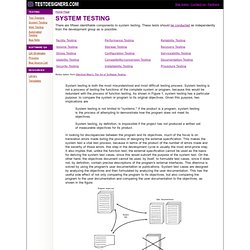

JDK Build Musings (Kelly O'Hair's Weblog) Here are some somewhat random musings on building the jdk and various build system observations.

It might be observed that some of these may sound like whining, I can assure you that whining is not allowed in my blog, only constructive criticism, it's everyone else that is whining. :^) Apologies for the length. Build and test of the JDK has multiple dimensions, and I cannot say that I have them all covered here, it is after all, just a blog, and I am not endowed with any supernatural guidance here. Continuous Build & Smoke Test Every component, every integration area, every junction point or merge point should be constantly built and smoke tested. I use the term smoke test because completely testing a product can take many weeks, and many tests do not lead themselves to being fully and reliably automated. How to write a software requirements specification. By Robert Japenga What Makes a Great Software Requirements Specification? There are many good definitions of System and Software Requirements Specifications that will provide us a good basis upon which we can both define a great specification and help us identify deficiencies in our past efforts.
There is also a lot of great stuff on the web about writing good specifications. The problem is not lack of knowledge about how to create a correctly formatted specification or even what should go into the specification. The problem is that we don't follow the definitions out there. We have to keep in mind that the goal is not to create great specifications but to create great products and great software. The IEEE (www.ieee.org) is an excellent source for definitions of System and Software Specifications. Advanced eclipse and Rational Team Concert (RTC) tips « MakerGeek. I spend pretty much most days working in and around RTC, and eclipse based tool for development and agile project development. Many of the great features are very obvious, others are not so much, but still really very helpful. Here I thought I would pull together some of the less obvious features of RTC and eclipse that are none the less very powerful and helpful, if only for the lazy (like me) RTC – First the set which are specific to RTC.
Rational Team Concert provides a very flexible tool for managing agile development from planning to coding through to building and managing several releases. Among the less obvious options are: ctrl+alt+w – This brings up a search dialog which lets you search for defects/tasks by number of just words that appear in the title or description. Team:History – If you right click on any file which is from a connected RTC respository you get a Team menu with some useful options in it.
Eclipse general awesomeness ${cursor} Like this: Like Loading... Myers, Glenford J. / Sandler, Corey / Badgett, Tom / Thomas, Todd M. - The Art of Software Testing. Software Test Designers - Testing and QA Bibliography. Software Test Designers - System Testing. System testing is both the most misunderstood and most difficult testing process.

System testing is not a process of testing the functions of the complete system or program, because this would be redundant with the process of function testing. As shown in Figure 1, system testing has a particular purpose: to compare the system or program to its original objectives. Given this purpose, two implications are System testing is not limited to "systems. " If the product is a program, system testing is the process of attempting to demonstrate how the program does not meet its objectives. In looking for discrepancies between the program and its objectives, much of the focus is on translation errors made during the process of designing the external specification. A command will be provided to view, from a terminal, the contents of main-storage locations. Output should be displayed as multiple lines of multiple words (in hexadecimal), with spacing between the words. System testing. System testing of software or hardware is testing conducted on a complete, integrated system to evaluate the system's compliance with its specified requirements.

System testing falls within the scope of black box testing, and as such, should require no knowledge of the inner design of the code or logic. [1] As a rule, system testing takes, as its input, all of the "integrated" software components that have passed integration testing and also the software system itself integrated with any applicable hardware system(s). System testing.